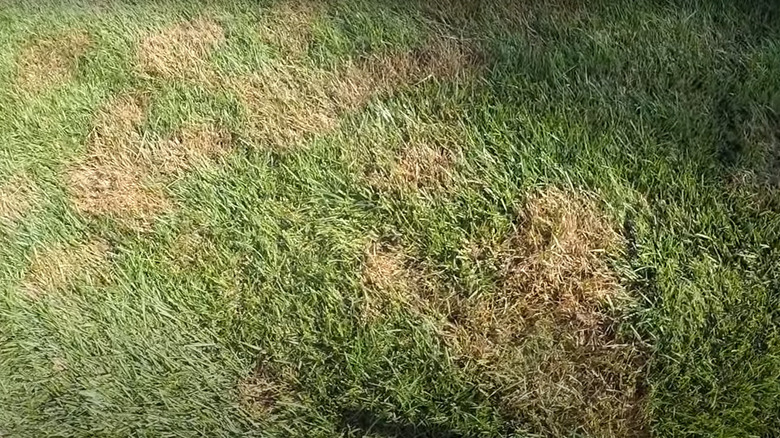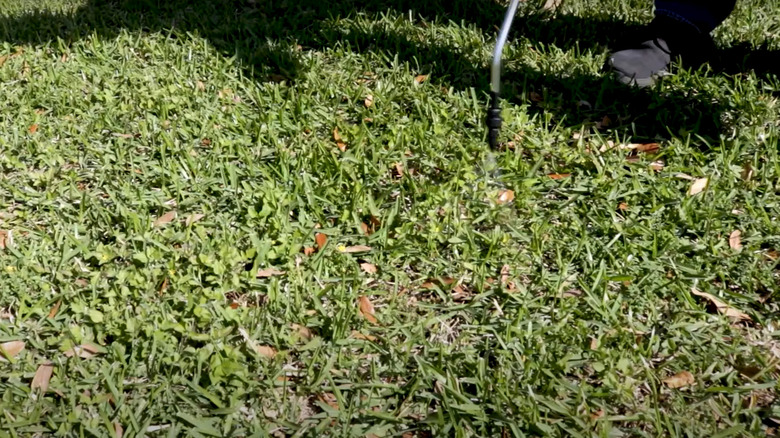The Major Drawback To Having Tall Fescue Grass
Easily adaptable across different climatic regions and soil types, tall fescue grass (Festuca arundinacea) has found itself a home in households too busy to care for their lawns astutely. This comes as no surprise given the tuft's resilience in dealing with drought stress, dense shade, and heavy foot traffic. Not to mention, some of its cultivars contain alkaloid-producing fungi that render them resistant to plenty of insect attacks (but may harm livestock). Yet, as is common to all grass types, tall fescue, too, has its downsides, with its defenselessness against brown patch disease (Rhizoctonia blight) being the most concerning.
While the tall fescue grass can easily withstand most tuft diseases, it suffers immensely under fungal afflictions like brown patch disease and gray leaf spot, with the former being more destructive. Mostly appearing as circular, tan patches on wet turf during the hot summer and late spring months, the blight quickly spreads, thins out, and kills the grass, especially if the sod isn't even a year old. Though rare, it can even damage the greenswards during the winter's warmer spells.
A disease-prone tuft
Brown patch disease happens when low maintenance turns into poor maintenance. Granted, you can't stop the weather fluctuations, but you can ensure the grass remains healthy throughout the hot season to prevent the resting disease-causing Rhizoctonia fungi from germinating and infecting the fescue blades. Practices like over- or late-watering that cause the leaves to remain moist for extended periods, poor drainage, insufficient aeration, and excessive nitrogen-rich fertilizer application are nothing short of inviting fungi over to a grass-eating barbeque.
Once seated in the deep-rooted grass, fungi showcase different results based on your mowing prowess. In shorter fescue tufts, measuring 1 inch or lower, the blight occurs as circular orange or tan patches that are further bordered by dark brown or gray fungus rings during extremely moist conditions (near 100% humidity) but fade out once the morning dew disappears. On the other hand, in a taller tuft, the brown disease progresses as 1 to 5 feet wide yellow or brown spots, with the swards developing irregular, tan lacerations with thin, deep brown margins. They may be interspersed with fluffy white mycelium growth during wet mornings. However, sometimes, the fungal infection may take the form of diffused, asymmetrical patches.
Prevention and maintenance
As the brown patch disease can make your lawn unsightly and even destroy the recently sown seedlings, implementing the right practices is essential to preventing its spread. Rework your irrigation schedule, sticking to a morning routine that affords the grass sufficient time to dry off before the evening (and fungi) sets in. Also, don't starve your green carpet, and water it whenever the top 4 to 6 inches of soil feel dry to the touch.
To boot, ensure the soil has optimum nitrogen, phosphorous, and potassium levels through a soil test. Fertilizer application is best carried out during the fall, but if you insist on early spring application, opt for a granular, slow-release product. However, remember not to add nitrogen to the grass if the brown patch disease has already damaged it. If the soil is compacted or drains poorly, carry out aeration and remove all thatch layers. In addition, maintain the ideal mowing height for the tall fescue variety — usually, anything between 2.5 and 3.5 inches is good. As a last resort, you can apply fungicides such as triadimefon, propiconazole, or myclobutanil. However, you might have to seek professional help if they don't work. Going forward, when reseeding the lawn, try growing the more resistant fescue varieties like the Kentucky-31.


